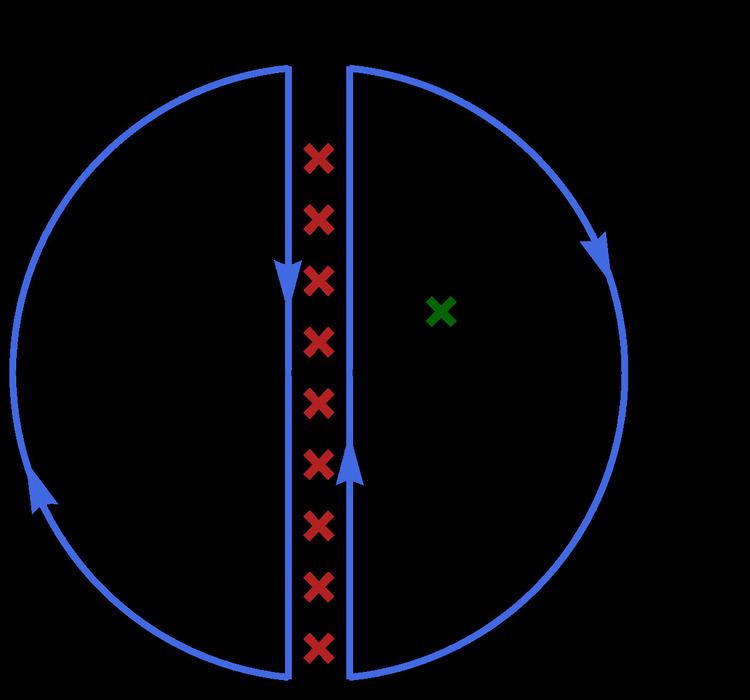 | ||
In thermal quantum field theory, the Matsubara frequency summation (named after Takeo Matsubara) is the summation over discrete imaginary frequencies. It takes the following form
Contents
- General Formalism
- Choice of Matsubara Weighting Function
- Table of Matsubara Frequency Summations
- Zero Temperature Limit
- Time Domain
- Operator Switching Effect
- Distribution Function
- Free Energy
- Diagrams Evaluation
- Fermion Self Energy
- Particle Hole Bubble
- Particle Particle Bubble
- Distribution Functions
- Relation to hyperbolic functions
- Parity
- Bose Fermi Transmutation
- First order
- Second order
- Formula of difference
- Case a0
- Case b0
- The function c
- Low temperature limit
- References
where
The summation will converge if g(z=iω) tends to 0 in z→∞ limit in a manner faster than
In addition to thermal quantum field theory, the Matsubara frequency summation method plays also an essential role in the diagrammatic approach to solid-state physics, namely, if one considers the diagrams at finite temperature.
Generally speaking, if at T=0 K a certain Feynman diagram is represented by an integral
General Formalism
The trick to evaluate Matsubara frequency summation is to use a Matsubara weighting function hη(z) that has simple poles located exactly at
As in Fig. 1, the weighting function generates poles (red crosses) on the imaginary axis. The contour integral picks up the residue of these poles, which is equivalent to the summation.
By deformation of the contour lines to enclose the poles of g(z) (the green cross in Fig. 2), the summation can be formally accomplished by summing the residue of g(z)hη(z) over all poles of g(z),
Note that a minus sign is produced, because the contour is deformed to enclose the poles in the clockwise direction, resulting in the negative residue.
Choice of Matsubara Weighting Function
To produce simple poles on boson frequencies
depending on which half plane the convergence is to be controlled in.
The case is similar for fermion frequencies. There are also two types of Matsubara weighting functions that produce simple poles at
In the application to Green's function calculation, g(z) always have the structure
which diverges in the left half plane given 0<τ<β. So as to control the convergence, the weighting function of the first type is always chosen
Table of Matsubara Frequency Summations
The following table concludes the Matsubara frequency summations for some simple rational functions g(z).
η=±1 marks the statistical sign.
[1] Since the summation does not converge, the result may differ by a constant upon different choice of the Matsubara weighting function.
[2] (1↔2) denotes the same expression as the before but with index 1 and 2 interchanged.
Zero Temperature Limit
In this limit
Some of the integrals do not converge. They should be regularized by introducing the frequency cutoff
meaning that at zero temperature, the free energy simply relates to the internal energy below the chemical potential. Also the distribution function is obtained by the following integral
which shows step function behavior at zero temperature.
Time Domain
Consider a function G(τ) defined on the imaginary time interval (0,β). It can be given in terms of Fourier series,
where the frequency only takes discrete values spaced by 2π/β.
The particular choice of frequency depends on the boundary condition of the function G(τ). In physics, G(τ) stands for the imaginary time representation of Green's function
It satisfies periodic boundary condition G(τ+β)=G(τ) for boson field. While for fermion field the boundary condition is anti-periodic G(τ+β)=-G(τ).
Given the Green's function G(iω) in the frequency domain, its imaginary time representation G(τ) can be evaluated by Matsubara frequency summation. Depending on the boson or fermion frequencies that is to be summed over, the resulting G(τ) can be different. To distinguish, define
with
Note that τ is restricted in the principal interval (0,β). The boundary condition can be used to extend G(τ) out of the principal interval. Some frequently used results are concluded in the following table.
Operator Switching Effect
The small imaginary time plays a critical role here. The order of the operators will change if the small imaginary time changes sign.
Distribution Function
The evaluation of distribution function becomes tricky because of the discontinuity of Green's function G(τ) at τ=0. To evaluate the summation
both choices of the weighting function are acceptable, but the results are different. This can be understood if we push G(τ) away from τ=0 a little bit, then to control the convergence, we must take
Bosons
Fermions
Free Energy
Bosons
Fermions
Diagrams Evaluation
Frequently encountered diagrams are evaluated here with the single mode setting. Multiple modes problem can be approached by spectral function integral.
Fermion Self Energy
Particle-Hole Bubble
Particle-Particle Bubble
Distribution Functions
The general notation
If necessary, the specific notations nB and nF are used to indicate Bose and Fermi distribution functions respectively
Relation to hyperbolic functions
The Bose distribution function is related to hyperbolic cotangent function by
The Fermi distribution function is related to hyperbolic tangent function by
Parity
Both distribution functions do not have definite parity,
Another formula is in terms of the
However their derivatives have definite parity.
Bose-Fermi Transmutation
Bose and Fermi distribution functions transmute under a shift of the variable by the fermionic frequency,
However shifting by bosonic frequencies does not make any difference.
First order
In terms of product:
In the zero temperature limit:
Second order
Formula of difference
Case a=0
Case a→0
Case b→0
The function cη
Definition:
For Bose and Fermi type:
Relation to hyperbolic functions
It is obvious that
To avoid overflow in the numerical calculation, the tanh and coth functions are used
Case a=0
Case b=0
Low temperature limit
For a=0:
For b=0:
In general,
